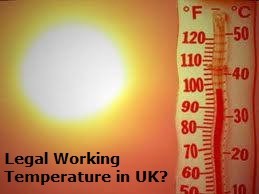WORKPLACE TEMPERATURES: Employers have requirements to provide their workers with a ‘reasonable’ temperature in the workplace.
But what is the minimum legal working temperature in the UK?
There is further guidance on the effects of workplace temperature. Find out when it becomes too cold, or when it is too hot, to work.
How does it affect working hours inside factory buildings, warehouses, and offices? Answers come from the Workplace (Health, Safety and Welfare) Regulations 1992. It covers the rules of the indoor legal temperature to work in UK.
The law states “employers have a legal obligation to provide a workplace for all their staff with a ‘reasonable‘ temperature in which to work”.
Minimum Legal Working Temperature UK
There is no absolute legal requirement for a minimum workplace temperature. But, an employer does have a duty to determine what a ‘reasonable’ comfort is in any particular circumstance.
Employers must abide by health and safety at work laws. They must provide a comfortable and legal temperature in the workplace for their employees, along with clean and fresh air.
The Approved Code of Practice makes several suggestions:
- If the workplace requires strenuous physical effort the minimum temperature should be 13 degrees Celsius.
- In a normal, indoor environment, the temperature should be a minimum of 16 degrees Celsius.
Note: Employees should discuss the matter with their employer if the working temperature is too uncomfortable for working.
Maximum Working Temperature for Employees

There can be no meaningful upper end of the temperature scale. This is due to certain environments, such as a smelting foundry or a plastic injection moulding unit.
But, work safety appropriate controls should be present in such environments.
Other factors, such as humidity, air velocity, and radiant temperature, also have a significance.
The interaction between them and the air temperature becomes more complex as the air temperature rises.
High Temperature Risk Assessment
Employers must address high temperature in the workplace to ensure they meet their legal obligations. To establish a sensible means of coping with high temperatures they should consult with their employees, or their appropriate representatives.
Further guidance comes from the Workplace Regulations, the Management and Safety at Work Regulations 1999. The topic relates to workplace health and safety risk assessments.
It requires that all employers assess the risks, to the workforce, of any health and safety issues. They must also take any necessary action to address the issues where it is reasonably practical for them to do so.
Managing Workplace Temperatures
Several factors determine the management of temperature at your workplace. They include factors such as whether you are operating indoors or outdoors.
The standard operating temperature of the environment should also be accountable. Other factors which may be relevant to your workplace include cold stress, heat stress, and dehydration.
UK Law for Indoor Workplaces
The compulsory rules include:
- Unless other UK employment laws require a lower temperature, the usual workroom temperature should be at least 16 degrees Celsius. But, 13 degrees Celsius is acceptable where strenuous work is likely.
- Localised heating or cooling should exist when variable hot and cold processes also exist in a work room.
- Rest facilities and thermal clothing must be available, where necessary, such as cold stores and ‘hot rooms‘.
- Use air conditioning and heating units that do not emit dangerous or offensive levels of fumes into the work area.
- Provide sufficient room to complete the required task in the workplace.
UK Laws for Outdoor Workplaces
What if your staff are working outdoors? There may be risks to their welfare from the effects of extreme weather conditions. Employers must follow UK health and safety rules and properly manage the situation.
The effects are not always immediate and can occur over an extended period of time. A typical example is the damage experienced by over-exposure to the rays of the sun.
Short time exposure can cause sunburn and blistering. Medium term exposure can cause skin ageing. Whereas long term exposures can increase the risk of skin cancer.
Note: Around 50,000 new cases of skin cancer get reported each year in the United Kingdom.
There are some common sense rules which can be easily applied to avoid unnecessary exposure:
- Wear hats with a wide brim rather than a simple ‘baseball’ cap.
- Take frequent rest breaks while working and drink sufficient amounts of water.
- Work in the shade where possible and take breaks in the shade (whenever practical).
- Wear long sleeve shirts or loose clothing with a close weave.
- Schedule work for cooler times of the day.
Note: Sun protection is vital to protect your employees’ health. A suntan is not a sign of good health and sunburn is a sign of damaged skin.

